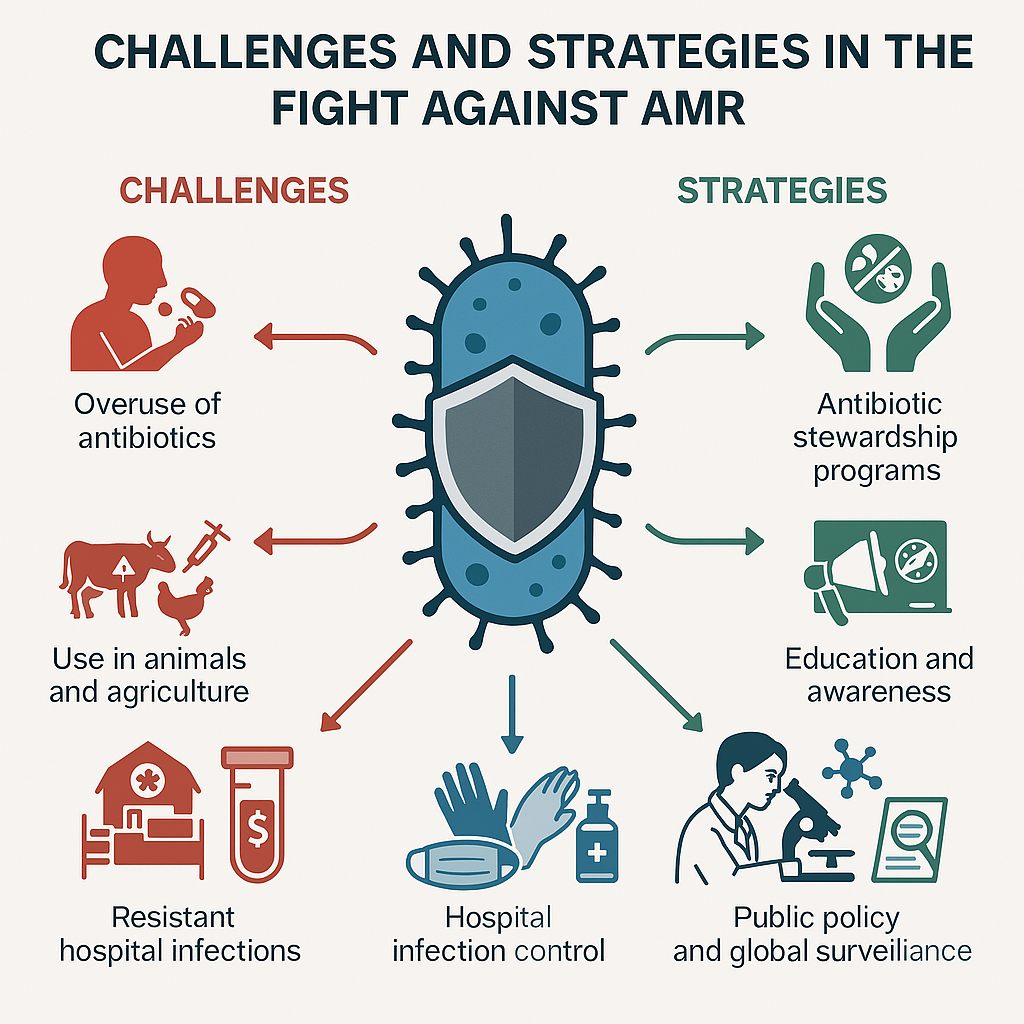Challenges and strategies in the fight against antimicrobial resistance
DOI:
https://doi.org/10.14295/bjs.v4i5.728Keywords:
public health surveillance, antibiotics, bacterial drug resistance, health strategiesAbstract
This study aims to evaluate the scientific literature on the challenges and strategies adopted in the fight against antimicrobial resistance. This study is a literature review, carried out in the SciELO, BVS, and PubMed databases, to analyze the challenges faced and the strategies employed in the fight against antimicrobial resistance. The challenges identified in the fight against antimicrobial resistance include the inappropriate use of antibiotics, the lack of regulation, the limited access to adequate treatments in certain areas, and the rapid adaptation of pathogens. Regarding the strategies, adopting measures for the rational use of antimicrobials, public awareness policies, and medical training, investments in research for the development of new antimicrobials, improvements in epidemiological surveillance, and the implementation of strict regulations on the use of antibiotics stand out. These results aim to provide a basis for more effective public policies in the fight against antimicrobial resistance. With the growing impact of antimicrobial resistance on both public health and the global economy, it is necessary and/or essential to implement effective strategies to contain its spread. Furthermore, the implementation of public policies, such as the WHO global plan and the Brazilian national plan, plays a fundamental role in mitigating the problem. Cooperation between the health sectors, pharmaceutical industries, and society is essential, since it can prevent the worsening of this crisis, ensuring the effectiveness of future available treatments.
References
Andrade, L. R. F. P. de, Santos, J. A., Gomes, D. C., Costa, C. J. L., Santana, J. R. L., Junior, J. C., … Bett , F. (2024). Resistência antimicrobiana e estratégias de combate: Uma revisão bibliográfica. A. R. International Health Beacon Journal, 1(4). https://healthbeaconjournal.com/index.php/ihbj/article/view/15
Araújo, B. C., Melo, R. C., Bortoli, M. C., Bonfim, J. R. A., & Toma, T. S. (2022). Prevenção e controle de resistência aos antimicrobianos na atenção primária à saúde: evidências para políticas. Ciencia & saude coletiva, 27(1), 299-314. https://doi.org/10.1590/1413-81232022271.22202020 DOI: https://doi.org/10.1590/1413-81232022271.22202020
Araújo, A. F., & Tacla, E. M. (2020). Microbiological profile and antimicrobial resistance profile of patients admitted to the Burn Unit of Hospital Geral «José Pangella» in Vila Penteado in Vila Penteado, Brazil. Revista Brasileira de Cirurgia Plástica, 35(2), 175-181. https://doi.org/10.5935/2177-1235.2020rbcp0030 DOI: https://doi.org/10.5935/2177-1235.2020RBCP0030
Braoios, A., Turatti, T. F., Meredija, L. C. S., Campos, T. R. S., & Denadai, F. H. M. (2009). Infecções do trato urinário em pacientes não hospitalizados: etiologia e padrão de resistência aos antimicrobianos. Jornal brasileiro de nefrologia: órgão oficial de Sociedades Brasileira e Latino-Americana de Nefrologia, 45(6). https://doi.org/10.1590/s1676-24442009000600003 DOI: https://doi.org/10.1590/S1676-24442009000600003
Camou, T., Zunino, P., & Hortal, M. (2017). Alarma por la resistencia a antimicrobianos: situación actual y desafíos. La Revista Medica del Uruguay, 33(4), 104-127. https://doi.org/10.29193/rmu.33.4.6 DOI: https://doi.org/10.29193/RMU.33.4.6
Cardoso, T., Almeida, M., Carratalà, J., Aragão, I., Costa-Pereira, A., Sarmento, A. E., & Azevedo, L. (2015). Microbiology of healthcare-associated infections and the definition accuracy to predict infection by potentially drug resistant pathogens: a systematic review. BMC Infectious Diseases, 15(1), 565. https://doi.org/10.1186/s12879-015-1304-2 DOI: https://doi.org/10.1186/s12879-015-1304-2
Corrêa, J. S., Zago, L. F., Silva-Brandão, R. R. da, Oliveira, S. M. de, Fracolli, L. A., Padoveze, M. C., & Currea, G. C. C. (2022). Antimicrobial resistance in Brazil: an integrated research agenda. Revista da Escola de Enfermagem da USP, 56, e20210589. https://doi.org/10.1590/1980-220X-REEUSP-2021-0589 DOI: https://doi.org/10.1590/1980-220x-reeusp-2021-0589
Figueiredo, E. A. P. de, Ramos, H., Maciel, M. A. V., Vilar, M. do C. M., Loureiro, N. G., & Pereira, R. G. (2007). Pseudomonas aeruginosa: freqüência de resistência a múltiplos fármacos e resistência cruzada entre antimicrobianos no Recife/PE. Revista Brasileira de Terapia Intensiva, 19(4), 421-427. https://doi.org/10.1590/s0103-507x2007000400003 DOI: https://doi.org/10.1590/S0103-507X2007000400003
Global action plan on antimicrobial resistance. (2015). World Health Organization, 28.Global action plan on antimicrobial resistance. (2023). World Health Organization, 14.
Giono-Cerezo, S., Santos-Preciado, J. I., Morfín-Otero, M. del R., Torres-López, F. J., & Alcántar-Curiel, M. D. (2020). Resistencia antimicrobiana. Importancia y esfuerzos por contenerla. Gaceta medica de Mexico, 156(2). https://doi.org/10.24875/gmm.20005624 DOI: https://doi.org/10.24875/GMM.20005624
Ministério da Saúde (2018). Gov.br. Obtido 8 de abril de 2025, de https://bvsms.saude.gov.br/bvs/publicacoes/plano_prevencao_resistencia_antimicrobianos.pdf
Silva, R. A. da, Oliveira, B. N. L. de, Silva, L. P. A. da, Oliveira, M. A., & Chaves, G. C. (2020). Resistência a Antimicrobianos: a formulação da resposta no âmbito da saúde global. Saúde em Debate, 44(126), 607–623. https://doi.org/10.1590/0103-1104202012602 DOI: https://doi.org/10.1590/0103-1104202012602
Trautner, B. W., Kaye, K. S., Gupta, V., Mulgirigama, A., Mitrani-Gold, F. S., Scangarella-Oman, N. E., Yu, K., Ye, G., & Joshi, A. V. (2022). Risk factors associated with antimicrobial resistance and adverse short-term health outcomes among adult and adolescent female outpatients with uncomplicated urinary tract infection. Open Forum Infectious Diseases, 9(12), ofac623. https://doi.org/10.1093/ofid/ofac623 DOI: https://doi.org/10.1093/ofid/ofac623
Viterbo de Faria, T., Pessalacia, J. D. R., & Silva, E. S. (2016). Fatores de risco no uso de antimicrobianos em uma instituição hospitalar: reflexões bioéticas. Acta Bioethica, 22(2), 321-329. https://doi.org/10.4067/s1726-569x2016000200019 DOI: https://doi.org/10.4067/S1726-569X2016000200019

Downloads
Published
How to Cite
Issue
Section
License
Copyright (c) 2025 Lígia Maria Oliveira de Souza, Alessandra Savi Bellizzi, Paloma Marcela Vigilato, Leidiane Barbosa Santos, Camylla Pimentel Pereira, Rosangela de Almeida Roxo, Gustavo de Oliveira, Bárbara Priscila Alves de Souza, Andrea Paola Britos Gómez

This work is licensed under a Creative Commons Attribution 4.0 International License.
Authors who publish with this journal agree to the following terms:
1) Authors retain copyright and grant the journal right of first publication with the work simultaneously licensed under a Creative Commons Attribution License that allows others to share the work with an acknowledgement of the work's authorship and initial publication in this journal.
2) Authors are able to enter into separate, additional contractual arrangements for the non-exclusive distribution of the journal's published version of the work (e.g., post it to an institutional repository or publish it in a book), with an acknowledgement of its initial publication in this journal.
3) Authors are permitted and encouraged to post their work online (e.g., in institutional repositories or on their website) prior to and during the submission process, as it can lead to productive exchanges, as well as earlier and greater citation of published work.



